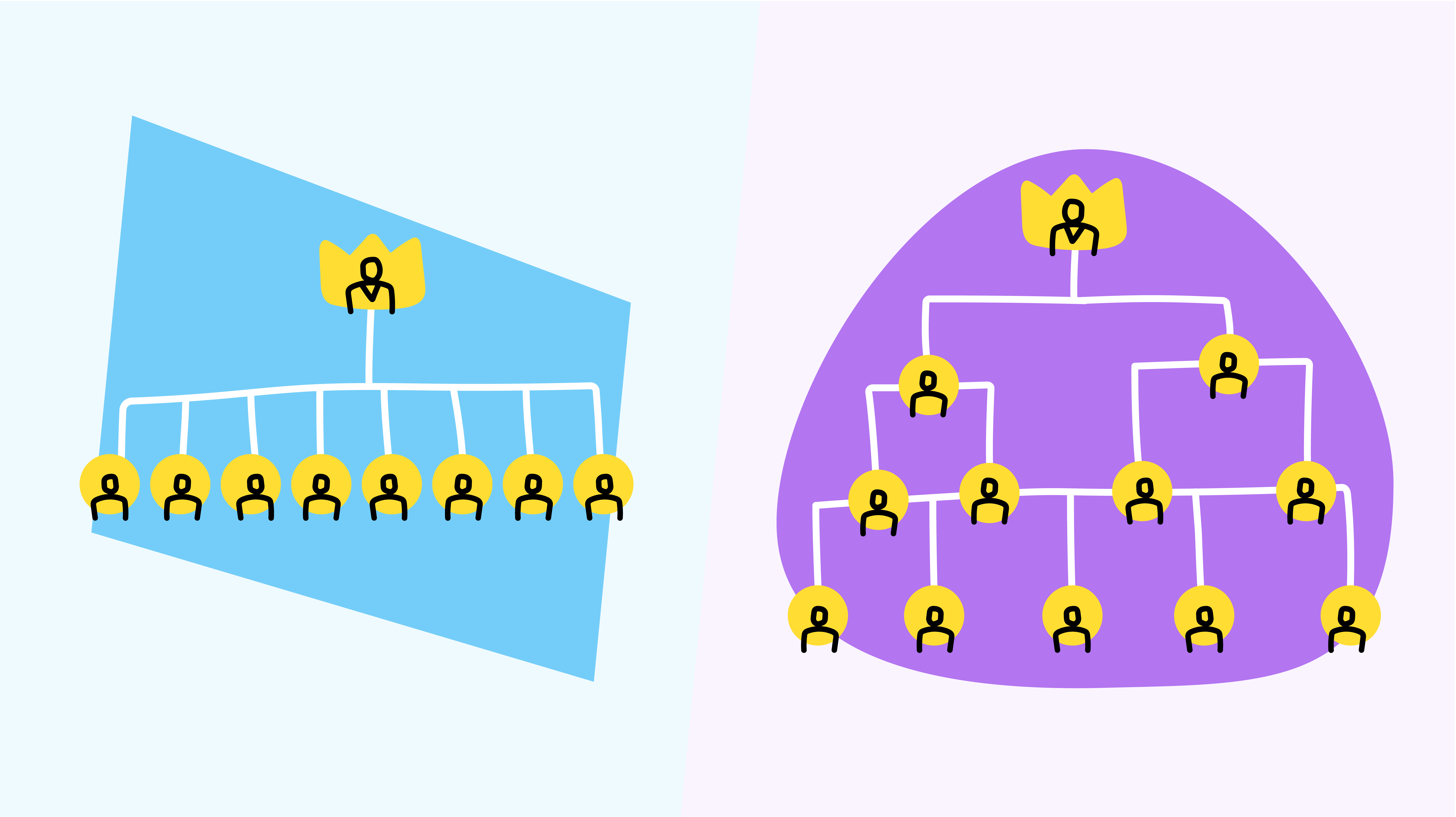4 min read

Most companies have opted for a hierarchical structure in the past, and for good reason. Its rigid format and a transparent chain of command have worked well in workplaces for as long as we can recall.
While hardly a new concept, the “new normal” of remote-first work has suddenly thrust the flat organizational model back into the limelight. As businesses adapt to a virtual work environment, a flat organization’s flexible and empowering nature suddenly looms as a tempting option.
To provide leaders with a clear choice according to their unique organizational circumstances, we’ve outlined the strengths and weaknesses of both hierarchical and flat organizational structures:
As technology has steadily made remote work more manageable, coupled with a pandemic that made it forcibly mainstream overnight—it has put stress on traditional hierarchical organizations while simultaneously making another structure intriguingly possible. We’re talking, of course, about a flat organizational structure.
Flat organizational structures, as its name suggests, are horizontal in nature. In essence, the goal of a flat organization is to have as few management levels as possible. Authority is redistributed to employees, who are less supervised and more empowered to get involved in problem-solving and making decisions.
Several benefits naturally come with a flat organizational structure:
Easier decision making: A flat organization removes the need to gain approval from busy or otherwise occupied authority figures.
Higher sense of employee responsibility: The lack of authority naturally imbues employees within a flat organization to take on an increased sense of responsibility that often jives with a collaborative leadership style.
Lower budget costs: The lack of a chain of command and approval procedures often leads to reduced overhead costs, as there are fewer salaries required for middle-management positions.
Faster communication: The necessity to send requests and messages up a chain of command, across departments, and then back down to other employees is eliminated in a flat organizational structure. Instead, direct, often asynchronous communication allows for fast communication that is particularly suited to a remote workforce.
While there are many pros, we can’t ignore the cons that should be considered when operating with a flat organizational structure, such as:
Difficulty maintaining structure throughout business growth: A flat system can often come under strain, and the lack of leadership can become apparent when a company scales operations and increases its workforce and activity.
Confusion without a chain of command: A lack of a transparent chain of command can make significant decisions difficult to execute at times. However, a detailed employee handbook can provide clear directions for codes of conduct, workplace policies, and other useful resources. This provides a blueprint to handle potential situations that could arise.
Work-life balance being hard to maintain: Employees in a flat organization can often struggle with the weight of excessive responsibilities and an inability to balance work with their personal lives.
At times, organizations might find that there’s no substitute for a traditional hierarchical managerial approach. This looks like a pyramid, with varying management layers that lead to a pinnacle consisting of a small oligarchy or even a single leader, often a CEO or president. Everyone else in the structure is under someone else’s authority and has a clearly defined role.
Better levels of responsibility and employee requirements: The expectations and requirements for each position within a hierarchical structure are usually clearly defined. However, this can often be difficult to maintain when everyone is working in a remote setting.
A clear picture of accountability: The buck always stops somewhere in a hierarchical organization, making it clear to know who is responsible and who should be reported to.
Specialized positions and responsibilities: If a specific task must be executed or a task needs to be assigned to someone, the internal awareness possible in a hierarchical structure makes it easier to identify exactly who should receive the work.
Less pressure on employees, especially new employees: Clear expectations, responsibilities, and team structure makes a hierarchical organization a more comfortable place for new employees to onboard and acclimate to their work. It also enables existing employees to remain unburdened by unnecessary stresses within the workplace.
Once again, while there are many positives, some of the drawbacks associated with a hierarchical structure include:
Complexity in cross-department communication: The need to go through a chain of command to communicate across departments can be crippling—although some larger hierarchical organizations, such as hospitals, still manage to maintain open lines of communication with efficiency.
Increased business costs: The necessity for an extensive middle-management staff often leads to excessive costs, especially related to corporate salaries and benefits.
Less collaboration between departments: The natural siloing effect of a hierarchical structure often creates difficult interdepartmental collaboration and efficiency. This is often exacerbated in a remote setting, where a lack of proximity further reduces bonding and the ability to work together.
A rigid structure limits innovation: The clearly defined structure and formulaic roles of a hierarchical organization can often leave little room for creativity and innovation within the rank and file.
It’s easy to pick a favorite organizational structure on paper, but the truth is, specific situations warrant different structures
In many classic office settings and business operations, a hierarchical structure’s format and authority can provide a much-needed sense of order and direction. However, in the remote-first, post-COVID-19 business landscape, a flat organizational structure can be the perfect way to bring together and empower a scattered workforce.
Either way, it’s essential that leaders take the time to identify what structure is best suited for their particular situation so that they can benefit from the efficiency and productivity that it provides.
Read more by
Jori Hamilton
Jostle’s employee success platform is where everyone connects, communicates, and celebrates at work. Find out more at jostle.me. © 2009–2025 Jostle Corporation. All rights reserved.